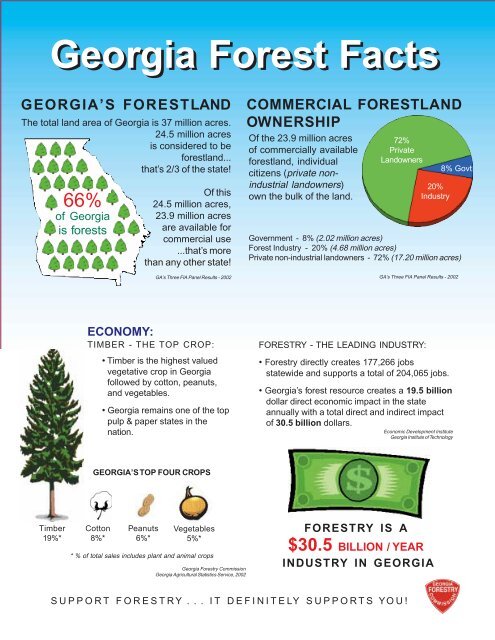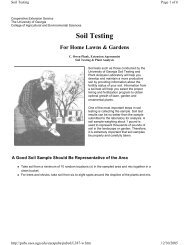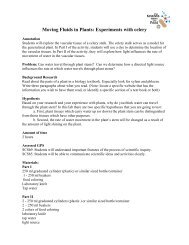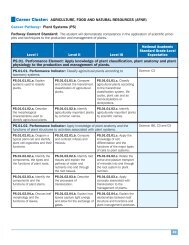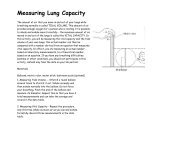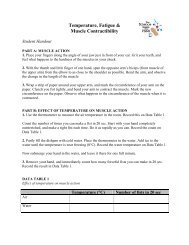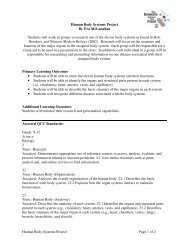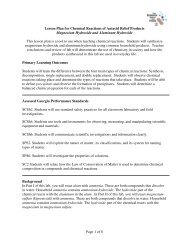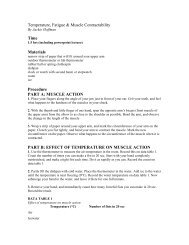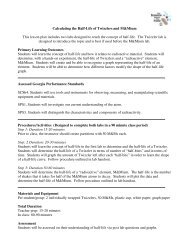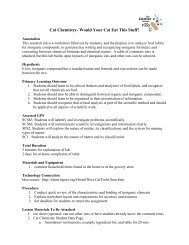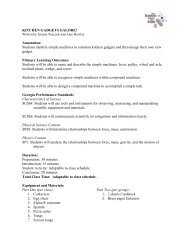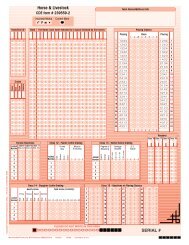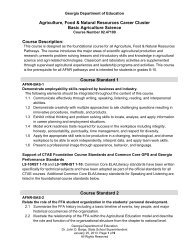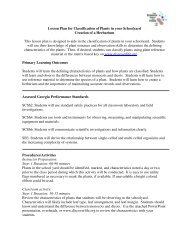2002 Forest Fact Sheet - the Georgia Agriculture Curriculum ...
2002 Forest Fact Sheet - the Georgia Agriculture Curriculum ...
2002 Forest Fact Sheet - the Georgia Agriculture Curriculum ...
You also want an ePaper? Increase the reach of your titles
YUMPU automatically turns print PDFs into web optimized ePapers that Google loves.
<strong>Georgia</strong> <strong>Forest</strong> <strong>Fact</strong>s<br />
GEORGIA’S FORESTLAND<br />
The total land area of <strong>Georgia</strong> is 37 million acres.<br />
24.5 million acres<br />
is considered to be<br />
forestland...<br />
that’s 2/3 of <strong>the</strong> state!<br />
66%<br />
of <strong>Georgia</strong><br />
is forests<br />
Of this<br />
24.5 million acres,<br />
23.9 million acres<br />
are available for<br />
commercial use<br />
...that’s more<br />
than any o<strong>the</strong>r state!<br />
GA’s Three FIA Panel Results - <strong>2002</strong><br />
COMMERCIAL FORESTLAND<br />
OWNERSHIP<br />
Of <strong>the</strong> 23.9 million acres<br />
of commercially available<br />
forestland, individual<br />
citizens (private nonindustrial<br />
landowners)<br />
own <strong>the</strong> bulk of <strong>the</strong> land.<br />
72%<br />
Private<br />
Landowners<br />
20%<br />
Industry<br />
8% Govt<br />
Government - 8% (2.02 million acres)<br />
<strong>Forest</strong> Industry - 20% (4.68 million acres)<br />
Private non-industrial landowners - 72% (17.20 million acres)<br />
GA’s Three FIA Panel Results - <strong>2002</strong><br />
ECONOMY:<br />
TIMBER - THE TOP CROP:<br />
• Timber is <strong>the</strong> highest valued<br />
vegetative crop in <strong>Georgia</strong><br />
followed by cotton, peanuts,<br />
and vegetables.<br />
• <strong>Georgia</strong> remains one of <strong>the</strong> top<br />
pulp & paper states in <strong>the</strong><br />
nation.<br />
FORESTRY - THE LEADING INDUSTRY:<br />
• <strong>Forest</strong>ry directly creates 177,266 jobs<br />
statewide and supports a total of 204,065 jobs.<br />
• <strong>Georgia</strong>’s forest resource creates a 19.5 billion<br />
dollar direct economic impact in <strong>the</strong> state<br />
annually with a total direct and indirect impact<br />
of 30.5 billion dollars.<br />
Economic Development Institute<br />
<strong>Georgia</strong> Institute of Technology<br />
GEORGIA’S TOP FOUR CROPS<br />
Timber<br />
19%*<br />
Cotton<br />
8%*<br />
Peanuts<br />
6%*<br />
Vegetables<br />
5%*<br />
* % of total sales includes plant and animal crops<br />
<strong>Georgia</strong> <strong>Forest</strong>ry Commission<br />
<strong>Georgia</strong> Agricultural Statistics Service, <strong>2002</strong><br />
FORESTRY IS A<br />
$30.5 BILLION / YEAR<br />
INDUSTRY IN GEORGIA<br />
SUPPORT FORESTRY . . . IT DEFINITELY SUPPORTS YOU!
REFORESTATION:<br />
• In <strong>the</strong> last 20 years (1983-<strong>2002</strong>), <strong>Georgia</strong>ns have<br />
replanted nearly 7.85 million acres in trees... that’s<br />
1,075 acres a day, which is 698,750 trees per day.<br />
• Approximately 1.78 trees are planted for every one<br />
harvested to ensure that future forests will continue<br />
to support our economy and environment.<br />
• An estimated 80,000 acres of forestland are<br />
naturally regenerated each year.<br />
2001-<strong>2002</strong> GFC Reforestation Survey<br />
FOREST PROTECTION:<br />
• <strong>Georgia</strong> experiences about 8,767 forest fires each<br />
year that damage or destroy approximately<br />
38,183 forest acres.<br />
• <strong>Georgia</strong> firefighters have <strong>the</strong> best fire suppression<br />
record in <strong>the</strong> Sou<strong>the</strong>ast with <strong>the</strong> average size fire<br />
consuming less than five acres.<br />
• Careless burning of debris continues to be <strong>the</strong><br />
leading cause of forest fires.<br />
Based on USFS Annual <strong>Forest</strong> Fire Statistics<br />
FOREST TYPE:<br />
• Commerical forestland in <strong>Georgia</strong> consists of:<br />
39.2% hardwoods, 16.2% oak/pine, 44% pine,<br />
and .6% non-stocked.<br />
• The most prevalent hardwood forest types are<br />
oak, maple, yellow poplar, and sweetgum.<br />
• Loblolly and slash are <strong>the</strong> primary pine forest types.<br />
HARDWOODS - 39.2 %<br />
OAK/PINE - 16.2 %<br />
PINE - 44 %<br />
GA’s Three FIA Panel Results - <strong>2002</strong><br />
Woods<br />
Arson<br />
18%<br />
Debris<br />
Burning<br />
49%<br />
Machine Use 11%<br />
Misc 6%<br />
Lightning 5%<br />
Children 4%<br />
Smoking 3%<br />
Railroad 3%<br />
Campfire 1%<br />
FIRES BY CAUSE<br />
GFC FY<strong>2002</strong> Fire Summary<br />
URBAN & COMMUNITY FORESTRY:<br />
Over 70% of <strong>Georgia</strong>’s population lives in urban areas. Urban and community trees make our communities livable.<br />
Benefits of healthy trees in urban & rural areas include: U.S. Census, 2000<br />
ECONOMIC<br />
BENEFITS:<br />
SOCIAL<br />
BENEFITS:<br />
ENVIRONMENTAL<br />
BENEFITS:<br />
FOREST PRODUCTS:<br />
Trees can be used to make thousands of consumer items. On <strong>the</strong> average,<br />
each American will use approximately 3 pounds of wood products per day.<br />
Products or by-products from trees include:<br />
Bandage strips<br />
Baseball bats<br />
Candles<br />
Capsules/Tablets<br />
Clothing<br />
Combs<br />
Cough syrup<br />
Crackers<br />
Crayons<br />
Eyeglass frames<br />
Football helmets<br />
Fruits & Nuts<br />
Gum<br />
Ice cream<br />
Lipstick<br />
Make-up<br />
• Enhance economic stability by attracting businesses and tourists<br />
• Reduce cooling and heating costs<br />
• Can add up to 15% to residential property value<br />
• Improve mental and physical health and well-being of people<br />
• Contribute to a sense of community pride and ownership<br />
• Provide privacy and a sense of solitude and security<br />
• Clean water, conserve water, and reduce soil erosion<br />
• Clean air and reduce air pollution<br />
• Create wildlife and plant diversity<br />
• Modify local climate<br />
Maple syrup<br />
Milk cartons<br />
Nail polish<br />
Newspaper<br />
Paint<br />
Parmesan cheese<br />
Pencils<br />
Perfume<br />
Photo film<br />
Shampoo<br />
Sponges<br />
Tires<br />
Toilet tissue<br />
Toothpaste<br />
J. Frederick Allen, Director<br />
<strong>Georgia</strong> <strong>Forest</strong>ry Commission<br />
P.O. Box 819<br />
Macon, GA 31202<br />
1-800-GA-TREES<br />
www.gfc.state.ga.us<br />
An Equal Opportunity<br />
Employer and Provider<br />
January 2003<br />
USDA <strong>Forest</strong> Service


